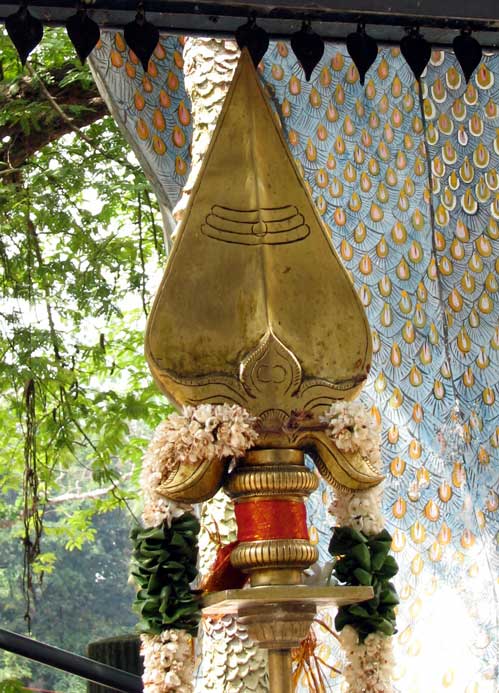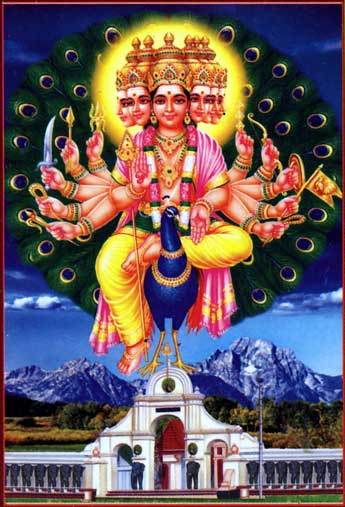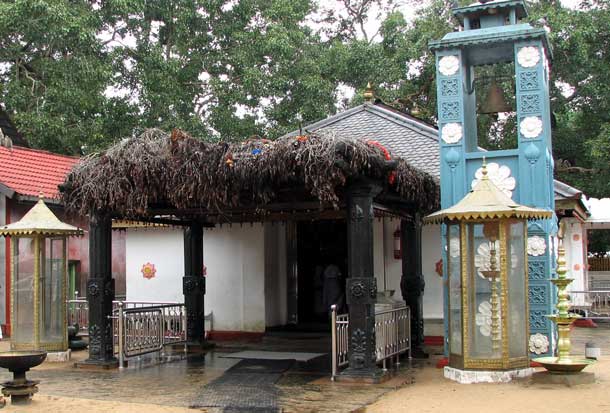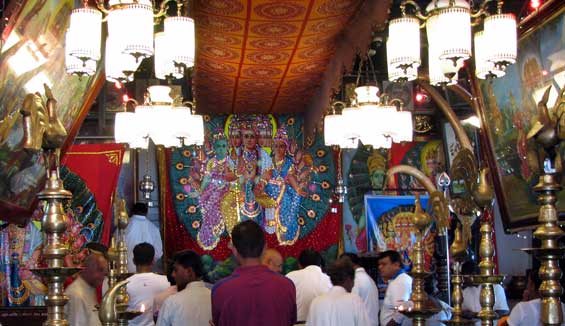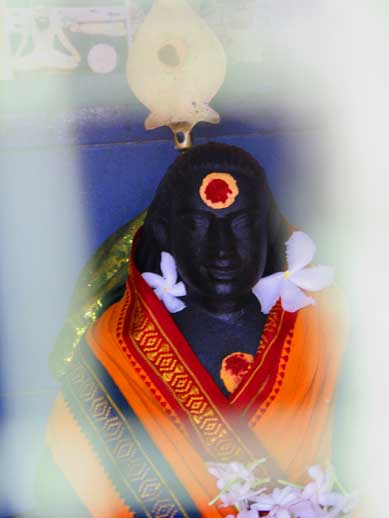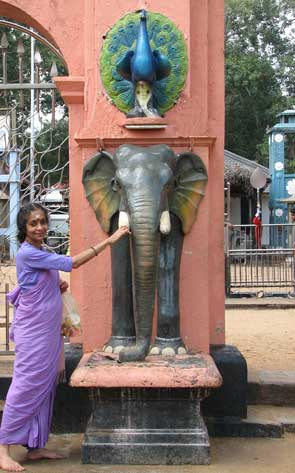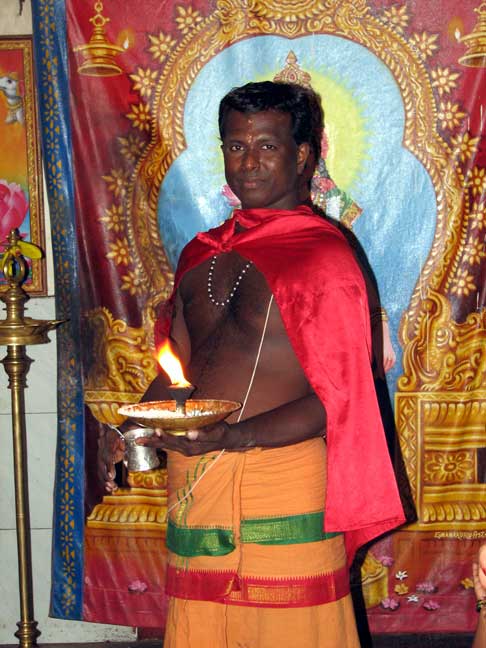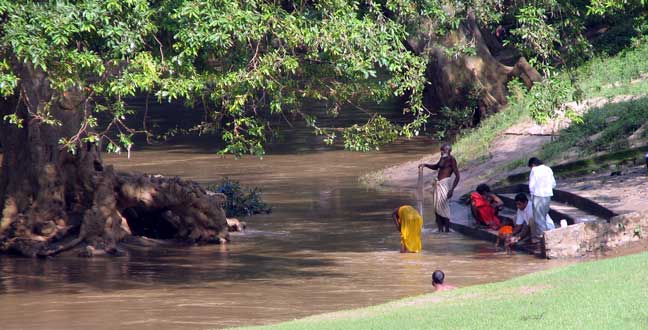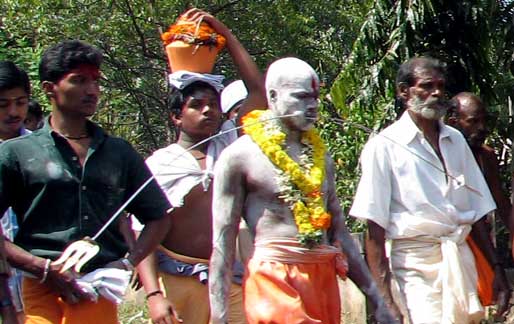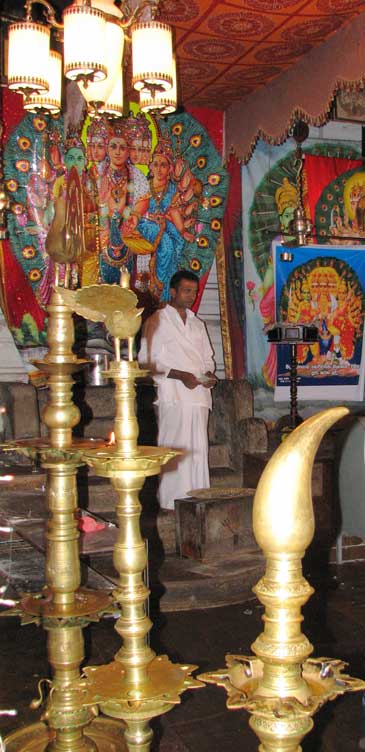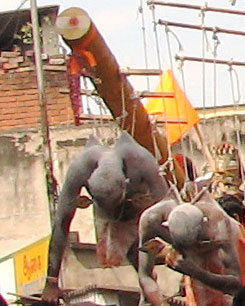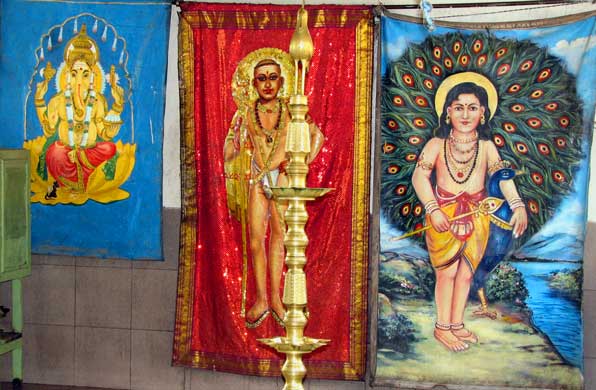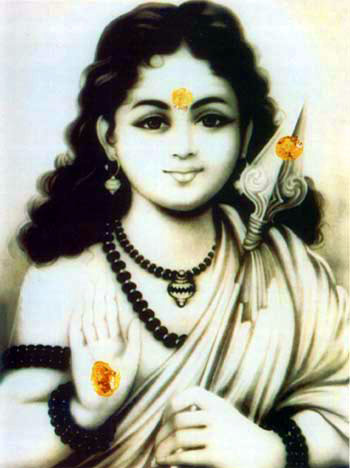
 Kataragama is sometimes known as dakshina Kailasa or the Kailasa of the south, Kailasa in the Himalayas and Kataragama in the far south constitute a north-south axis not merely in yogic lore but also in geography. They both lie on the same line of longitude – 80.10 degrees east. This fact was well known to all the yogis who lived in Kataragama. This axis refers to the sushumna nadi or subtle nerve centre that runs through the human spine. All the seven chakras or subtle centres of psychic energy are located along this nerve. Kailasa in the Himalayas corresponds to the Sahasrara Chakra or the thousand petal led lotus, which is the seat of Shiva, while Kataragama is likened to the Muladhara Chakra situated just above the anus in the human body. The Devi Kundalini lies curled up just above the Muladhara Chakra and is the point of entry for those who want to practice Kundalini Yoga. She has to be awakened by yogic practices and forced to rise up through all the chakras until she attains union with Shiva in the Sahasrara Chakra. This axis is also likened to the light, which was emitted from the Supreme at the start of creation. In south India it is said that all the exploits of Kartikeya took place on the Indian continent but according to the Sri Lankan version he travelled from Kailasa to Kataragama on the island of Sri Lanka. Strangely enough both these places lie on the same line of longitude. Kartikeya is supposed to have crossed the straits to Sri Lanka and then gone on foot to the hill of Katirmalai (hill of light) from where he led the host of the gods and defeated the demons. The Skanda Purana also indicates that Murugan fought the demons at this place.
Esoterically speaking the descent of Skanda from Uttara Kailasa to Dakshina Kailasa or Kataragama is an allegory for the descent of Spirit into matter. This is further enhanced and made into the story of Murugan and Valli. Murugan, the Supreme Spirit comes to earth to woo and wed the yearning human soul as portrayed by Valli. The very name of the place katir-kaman supports this idea. “Katir” means effulgence or light and “kaman” passion or love. The effulgence comes from Kailasa and kindles into the flame of passion – that is to say the Paramatma descends into the human form and weds the aspiring jivatma. In ancient times when sacred geography played an important role in the construction of important towns, a configuration of seven hills was considered to be an ideal location for the capital of a state or for the construction of a temple. Notable examples in Europe are Athens, Rome, Constantinople and Jerusalem. In India the famous temple of Thirupathi is located on seven hills and the same applies to Kataragama, which is also on seven hills. The number seven signifies the reversal, return and integration of the soul to its original status of innocence. This is the object of all those who follow Kumara or Murugan.
Katargama Temple Bhogarnatha as well as many other siddhas and saints are connected with this shrine. But strangely enough there is no icon or idol of Murugan in this place. His aspect as pure consciousness alone is worshipped here. The sanctum sanctorum contains a small casket with the shat-kona yantra, which is a mystic design in which two triangles interlock. The six points thus created refer to the six cardinal points of space. Thus the six-faced Shanmukha is the Lord of Space. He is the conscious presence abiding at the source and centre of our three-dimensional world, which is a field of infinite possibilities. The Sri Lankans believe that Kartikeya’s entire career took place on this hill for it is here that the six cardinal points of space collapse and return to their undivided singularity. The most well-known and romantic incident in Murugan’s career took place here. This was his secret courtship and marriage with Valli Amman, the daughter of the chief of the Veddas, who were the indigenous tribes of the forest. From a conventional point of view, this union of a god and a tribal girl, almost an outcaste is a gross mis-match. But as we have seen, this combining of the two, represents the union of the Supreme Spirit with the earth bound soul that craves for this merger. The legend attached to this temple is as follows. Lord Murugan had taken an incarnation in South India by the name of Kataragama. His wife’s name was Tevayani. This name is actually the Sri Lankan distortion of the name Devayani or Devasena, who was Subramanya’s first consort. It so happened that Kataragama had a quarrel with Tevayani and left her and went to the island of Sri Lanka. He proceeded to the hill called Katirmalai, which was the abode of the tribe called the Veddas. This hill is just above the present day shrine of Kataragama. One day when he was out hunting, he met the adopted daughter of the Vedda chief known as Valli. The rest of the story is the same as the romance of Valli and Subramanya described in many of the Puranas.
Inside Katargama Temple In the Hindu tradition, vows play an important role in the relationship between the deity and the devotee. Though a child, Valli had made a vow that she would marry no man but Murugan himself. This is the core of the legend of Kataragama. In Sinhalese folklore Lord Kataragama also makes a solemn vow that he would ever remain at Kataragama to help and protect his devotees. Murugan’s devotees are famous for making difficult vows in order to gain his grace. They pierce their cheeks with arrows and walk barefoot on hot coals. But strangely enough none of them seem to get hurt. The story of their romance is most intriguing. Murugan knew of Valli’s vow but he did not approach her in his own form but in a series of disguises. As we have seen in Kataragama temple there is no idol. Only the yantra is worshipped. Thus in this place Murugan is regarded as formless. Therefore whatever form or face he chooses to show is only a guise. His true devotee is expected to penetrate the disguise and realise that he is indeed formless. Due to his tricks and methods of teasing his devotees, the Lord of Kataragama, like Krishna is lovingly called a thief and a rogue! Kataragama found Valli in the millet field and approached her as a handsome young hunter and proposed to her in a brazen attempt to make her violate her vow. She adamantly refused to succumb to his charms. Next day he took the form of an old Brahmin and tottered in front of her and begged for some food. She offered fruit and honey, which was all she had, but he said he needed water to wash it down. She agreed to show him the way to the well. On the way he asked her if she was not afraid of living in a field in the midst of the jungle all alone when the men were away hunting. She said she was afraid of nothing except elephants. Immediately Ganesha appeared in front of them as an elephant and Valli clung to the old man and begged him to save her. He said he would do so only if she agreed to marry him. She promptly agreed and he brought her back safely to her village. When her family saw them they rushed to attack Kataragama whereupon he changed himself into a tree. The Veddas proceeded to cut down the tree but at the very first blow, blood gushed out of the wound so the Veddas discovered his identity. They realised that he was Murugan, the god they had been worshipping for centuries so they joyously agreed to the marriage. Thus Kataragama and Valli lived happily together for many years.
Babaji at Katargama In the meantime Tevayani was tired of her lonely existence and sent Kataragama’s teacher who was known as Muttulingam Swami as well as a Muslim called Mohammed Navi, to search for her husband. They knew that he had gone to Sri Lanka so they followed him and eventually came to the region of the Veddas. However they were unable to locate him even though they wandered in the forest for a long time. They were on the point of giving up the task when Muttulingam Swami discovered that someone else had smoked the opium pipe that he had used and left on the hill the previous day. He knew immediately that only Kataragama would have dared to do such a thing. Once again they started searching for him even more earnestly and very soon discovered him. They insisted that he accompany them back to India. The thought of forsaking Valli was inconceivable, so he refused to go. Instead, he persuaded his guru, Muttulingam to stay behind but the Muslim, Mohammed Navi returned to India and blurted out the whole story to Tevayani. She was determined to get her husband back and went post haste to Sri Lanka. She found Kataragama and pleaded with him to return to their home in India but he refused. So she decided to stay on with the Veddas. It appears that the Muslim, Mohammed Navi had also followed her. The Veddas accepted all of them and they lived amicably together till the end of their lives. When they died the Veddas built a temple for Muttulingam Swami and a mosque for Mohammed Navi on either side of the temple of Valli. They also built a shrine for Tevayani. Obviously the mosque was built in order to reconcile the two religions. Muslims are allowed to visit the shrine at all times except the time of the main puja, since Mohamed Navi was the one who had betrayed Kataragama. If any Muslim is found inside at that time, he is severely beaten. However at other times all castes and religions are welcome to Kataragama, which has become a Mecca for Muslims as well as a Kailasa for Hindus. Lord Murugan, in his form as Kataragama is available to all, irrespective of caste, creed or social status. His grace is abundantly given to all.
Kataragama has all the three points which all sacred shrines are supposed to have -murti, or idol, sthalam or holy spot, and teertham or holy river. The sacred yantra, or mathematical figure imbued with spiritual power is kept in the place of the idol. The sthalam or place is the holy hill known as Katirmalai and the teertham or river is called the Manika Ganga or the Ganga of gems. Kataragama has an amazing ambience. The atmosphere is filled with mystery and magic. Countless miracles keep taking place here. The main temple has two apartments. The sanctum sanctorum is heavily veiled with seven curtains. It does not have an idol of Kataragama. Instead it has a casket, which contains the mysterious yantra (mystic diagram), which is embossed on a golden tablet studded with gems. This is where the divine power is supposed to reside. The Lord in his nada bindu form (form of letters and sound) is enshrined in the yantra. The great sage Kalyana Giri who was a disciple of Bhogarnatha made this yantra. By his intense tapasya he made Murugan available to every devotee through this yantra. He is supposed to have come from North India and done intense tapasya for twelve years chanting the great mantra of Murugan, (Aum Sharavanabhava) without sleeping. When he went into Samadhi the Veddas were supposed to have looked after him and thus got the blessings of Kataragama. The place where the sage had sat for his tapasya is the sanctum sanctorum of the temple where the casket containing the yantra is kept.
Kartagama Priest After he left his body, two other sages also known as Kalyana Giri, are supposed to have taken over the puja of the yantra. The priests who came after them still conduct pujas according to the rites as established by them, which is what was originally taught to them by the Veddas. So it is tribal in character. They tie up their mouths with a white cloth when they offer the pujas so as not to defile the articles used in the ritual with spit, which might fly from their mouths. They also offer fruits and honey from the jungle rather than elaborately cooked foods. The Kataragama Mahadevale temple is on the left bank of the Manika Ganga, which is the holy river, which flows near Kataragama. It is here that Murugan is supposed to reside. The place is shrouded with mystery. It is a modest single story building and is said to have been built in the 2nd century BC by the Sinhalese king Duttugemunu who was directed to build the temple by Lord Kataragama himself. Yogis who meditate here say that the temple has actually seven stories – three above and three below apart from the ground floor, which everyone can see. These correspond to the seven lokas or astral worlds that lie above this planet. In fact the temple is a microcosm of the hierarchical cosmos described in Indian tradition. Certain places on earth are believed to exude a mystic power since they are in direct contact with their subtle counterparts in the astral worlds. The Mahadevale temple is one such place.
Another interesting feature of Kataragama is the famous pada yatra or pilgrimage on foot. It is a tradition, which has been inherited from the island’s indigenous forest dwellers – the Veddas. The devotees start from the far south of the island. They take about forty-five days to two months to reach the Kataragama shrine in the remote north-eastern jungle. The yatra is timed so that the devotees can reach the temple in time for the biggest festival there. This custom existed long before the arrival of the other major religions associated with this shrine.
Pilgrim with cheeks pierced with silver vail. The pada yatra is not a mere walking journey but a spiritual passage through subtle dimensions that are revealed only to the devout participant. The pilgrims traverse through the shadowy world of outward appearances and penetrate into the effulgent realm of “katir kaman” or “light and delight”. Only one who is imbued with faith can appreciate what it means to cross the threshold of ordinary time and plunge into the realms of sacred time and sacred space. The voyage to the innermost sanctum is a spiritual journey into one’s own metaphysical centre. The festival for which the pilgrims come, starts on the new moon day of the Tamil month of Adi - July\August and ends on the full moon day of the same month (Adi), which comes in August. Thus the worship of Murugan is connected with the lunar cycle. The new moon marks the beginning of the ritual associated with Murugan and ends with the full moon denoting fulfilment. Each night during the festival, the sacred casket enclosing the yantra is placed on the back of an elephant and taken round in a procession round the temple. It is said that when it reaches the shrine of Tevayani the drums beat very loudly in order to drown her cries of protest! Apparently she has not stopped her supplication of Kataragama, entreating him to return with her to India.
Inside Katargama Temple Devotees of Murugan undertake many vows. One of the strange sights here is that of pilgrims carrying earthen pots with burning camphor on their heads while they follow the procession. Strangely enough none of them seem to get their heads burnt by this unique offering. A day prior to the termination of the festival, there is a fire-walking ceremony. Only devotees, who are inspired by the deity to be a vehicle for the exhibition of divine power, dare to take part in the ceremony. In the early hours of the morning they bathe in the sacred water of the Manika Ganga or the river of gems, and then step barefoot on to the forty feet track of burning embers fearlessly. To the amazement of spectators none of them who have thus been inspired ever get burnt. “Those who come to scoff remain to pray”! There are other indigenous forms of worship here that are even more amazing to behold. Some pilgrims go round with their mouths gagged so that they cannot talk or eat. Others have their lips and cheeks pierced with silver-headed pins. Some votaries hang themselves on hooks to a tree that is especially reserved for this purpose. The hooks are pierced through the flesh of their backs! These types of customs might seem barbarous to the modern mind, which is the western mind, but it must be realised that whatever form of self-punishment is undertaken as a fulfilment of a vow, the devotee is found to be unscathed at the end of the process. This can only be called miraculous.
Pilgrims Offering Hanging Tapas Sometimes inexplicable trances and possession by the spirit of Kataragama are found amongst the pilgrims. No scientific explanation is feasible for the doubting modern mind. Another common experience during the festival is for children to get lost but invariably they are always brought back to their parents in a mysterious manner. Murugan in the form of Kataragama is supposed to answer the prayer of sincere devotees in many mystifying ways. He appears in various human forms and gives them advice. But when they search for the person later, he is never to be found. The history of Kataragama abounds with innumerable episodes of this nature.
Ancestral memory and present day happenings bear witness to the thousands of miracles that have been enacted on this stage by the divine play of Lord Kataragama. Millions of boons have been received through his ever-abounding grace. The subtle presence of many siddhas who have lived here many years ago are felt by people even now. Naga puja or snake worship existed here from about 220 BC and still continues. As we have seen, worship of Murugan is considered the best way to alleviate the effects of “sarpa dosha” or the curse of the snakes. Many cures are affected here of people getting cured after having been bitten by the poisonous snakes that abound in the neighbouring forest. The sacred vibhuti or ashes in this temple is obtained by digging at a place called “vibhuti malai”. This again is another divine mystery since no one knows how it got there. Indeed there are many such inexplicable happenings in this extraordinary temple. Till very recent times the only way to reach Kataragama was by foot. The path led through thick equatorial jungle, infested with snakes and wild animals. It was very similar to the pilgrimage to Sabarimala, which will be described later. Only the intrepid and the faithful could make this hazardous journey and return home alive. Even today there are a few people who still follow this ancient trail and go on foot. Now of course the town has been connected by road to all major cities of Sri Lanka so most people prefer the safe method of going by some motor vehicle. Even in this age of scepticism, Kataragama is an extraordinary place where strange things happen which appear to defy the laws of science. Most Hindus believe that the pilgrimage to Kataragama is feasible only if Murugan himself issues an invitation. It was entirely due to HIS grace that the web master and Mataji were able to make this extraordinary journey to this mystic place last December.
O Shanmukha! I worship thy twelve arms. That punished Brahma, That governs the world through thy lila, Those arms that killed Yama, Surapadma and other enemies of Indra, Those arms that are matchless in protecting the universe. And which are a terror to thy enemies, Subramanya Bhujagam by Adi Shankaracharya. Sharavanabhava!
*Sharavanabhava mantra from Mantras for Meditation, Volume 2, by Prof.R.Thiagarajan Geethanjali Label, Super Audio (Madras) Pvt.Ltd Mp3 Download at: http://www.tradebit.com/filedetail.php/1505558 |
